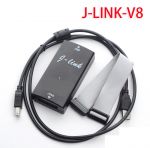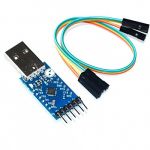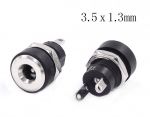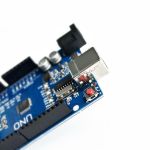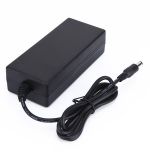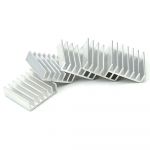Local Storage seems to be disabled in your browser.
For the best experience on our site, be sure to turn on Local Storage in your browser.
RF Transceiver Module RFM69HCW 433MHZ
The RFM69HCW is a transceiver module capable of operation over a wide frequency range, including the 433 MHz license-free ISM (Industry Scientific and Medical) frequency bands. All major RF communication parameters are programmable and most of them can be dynamically set. The RFM69HCW offers the unique advantage of programmable narrow-band and wide-band communication modes. The RFM69HCW is optimized for low power consumption while offering high RF output power and channelized operation. Compliance ETSI and FCC regulations. In order to better use RFM69HCW modules, this specification also involves a large number of the parameters and functions of its core chip RF69H's, including those IC pins which are not led out. All of these can help customers gain a better understanding of the performance of RFM69HCW modules, and enhance the application skills.

Feature and application:
Features:
-
+20 dBm - 100 mW Power Output Capability
-
High Sensitivity: down to -120 dBm at 1.2 kbps
-
High Selectivity: 16-tap FIR Channel Filter
-
Bullet-proof front end: IIP3 = -18 dBm, IIP2 = +35 dBm,80 dB Blocking Immunity, no Image
-
Frequency response
-
Low current: Rx = 16 mA, 100nA register retention
-
Programmable Pout: -18 to +20 dBm in 1dB steps
-
Constant RF performance over a voltage range of module
-
FSK Bit rates up to 300 kb/s
-
Fully integrated synthesizer with a resolution of 61 Hz
-
FSK, GFSK, MSK, GMSK and OOK modulations
-
Built-in Bit Synchronizer performing Clock Recovery
-
Incoming Sync Word Recognition
-
115 dB+ Dynamic Range RSSI
-
Automatic RF Sense with ultra-fast AFC
-
Packet engine with CRC-16, AES-128, 66-byte FIFO
-
Built-in temperature sensor
-
Module Size:16X16mm
Applications:
-
Automated Meter reading
-
Wireless Sensor Networks
-
Home and Building Automation
-
Wireless Alarm and Security Systems
-
Industrial Monitoring and Control
-
Wireless M-BUS
Block Diagram:
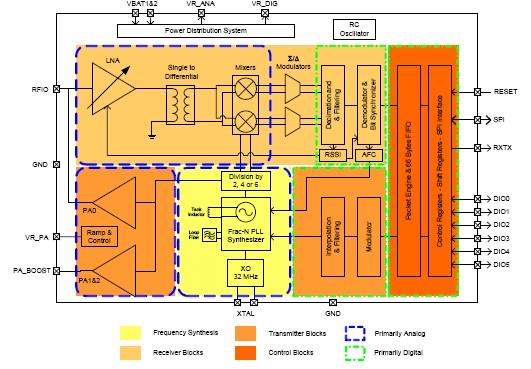
Pin diagram:
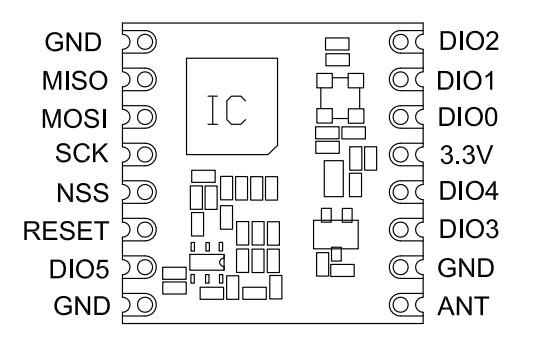
Pin Description:
-
Number
Name
Type
Description
1
GND
-
Ground
2
MISO
I
SPI Data output
3
MOSI
O
SPI Data input
4
SCK
I
SPI Clock input
5
NSS
I
SPI Chip select input
6
RESET
I/O
Reset trigger input
7
DIO5
I/O
Digital I/O, software configured
8
GND
-
Ground
9
ANT
-
RF signal output/input.
10
GND
-
Ground
11
DIO3
I/O
Digital I/O, software configured
12
DIO4
I/O
Digital I/O, software configured
13
3.3V
-
Supply voltage
14
DIO0
I/O
Digital I/O, software configured
15
DIO1
I/O
Digital I/O, software configured
16
DIO2
I/O
Digital I/O, software configured
Electrical characteristics:
Absolute Maximum Ratings:
Stresses above the values listed below may cause permanent device failure. Exposure to absolute maximum ratings for extended periods may affect device reliability.
-
Symbol
Description
Min
Max
Unit
VDDmr
Supply Voltage
-0.5
3.9
V
Tmr
Temperature
-55
+115
° C
Tj
Junction temperature
-
+125
° C
Pmr
RF Input Level
-
+6
dBm
DC_20dBm
Duty Cycle of transmission at +20dBm output
-
1
%
VSWR_20dBm
Maximum VSWR at the antenna port
-
3:1
-
Operating range:
-
Symbol
Description
Min
Max
Unit
VDDop
Supply voltage(1.8V-2.4V 17dBm, 2.4V- 3.6V 20dBm)
1.8
3.6
V
Top
Operational temperature range
-40
+85
°C
Clop
Load capacitance on digital ports
-
25
pF
ML
RF Input Level
-
0
dBm
Module consumption:
The tables below give the electrical specifications of the transceiver under the following conditions: Supply voltage VBAT1=VBAT2=VDD=3.3 V, temperature = 25 °C, Pout = +13dBm, 2-level FSK modulation without pre-filtering, FDA = 5 kHz, Bit Rate = 4.8 kb/s and terminated in a matched 50 Ohm impedance, unless otherwise specified.
Note: Unless otherwise specified, the performances in the other frequency bands are similar or better.
Power consumption:
-
Symbol
Description
Conditions
Min
Typ
Max
Unit
IDDSL
Supply current in Sleep mode
-
0.1
1
uA
IDDIDLE
Supply current in Idle mode
RC oscillator enabled
-
1.2
-
uA
IDDST
Supply current in Standby mode
Crystal oscillator enabled
-
1.25
1.5
mA
IDDFS
Supply current in Synthesizer mode
-
9
-
mA
IDDR
Supply current in Receive mode
-
16
-
mA
IDDT
Supply current in Transmit mode with appropriate matching, stable across VDD range
RFOP=+20dBm,
onPA_BOOSTRFOP = +17 dBm, onPA_BOOST
RFOP = +13 dBm, on RFIO pin RFOP = +10 dBm, on RFIO pin RFOP = 0 dBm, on RFIO pin
RFOP = -1 dBm, on RFIO pin
-
-
-
-
-
-
130
95
45
33
20
16
-
-
-
-
-
-
mA
mA
mA
mA
mA
mA
Frequency synthesis:
-
Symbol
Description
Conditions
Min
Typ
Max
Unit
FR
Synthesizer Frequency Range
315MHz Module
433MHz Module
868MHzModule
915MHzModule
290
424
862
890
340
510
890
1020
MHz
MHz
MHz
MHz
FXOSC
Crystal oscillator frequency
For All Module
-
32
-
MHz
TS_OSC
Crystal oscillator wake-up time
-
250
500
us
TS_FS
Frequency synthesizer wake-up time to PllLock signal
From Standby mode
-
80
150
us
TS_HOP
Frequency synthesizer hop time at most 10 kHz away from the target
200 kHz step
1 MHz step
5 MHz step
7 MHz step
12 MHz step
20 MHz step
25 MHz step
-
-
-
-
-
-
-
20
20
50
50
80
80
80
-
-
-
-
-
-
-
us
us
us
us
us
us
us
FSTEP
Frequency synthesizer step
FSTEP = FXOSC/219
-
61.0
-
Hz
FRC
RC Oscillator frequency
After calibration
-
62.5
-
kHz
BRF
Bit rate, FSK
Programmable
1.2
-
300
kbps
BRO
Bit rate, OOK
Programmable
1.2
-
32.768
kbps
FDA
Frequency deviation, FSK
Programmable
FDA + BRF/2 =< 500 kHz
0.6
-
300
kHz
Receiver:
All receiver tests are performed withRxBw= 10 kHz (Single Side Bandwidth) as programmed inRegRxBw, receiving a PN15 sequence with a BER of 0.1% (Bit Synchronizer is enabled), unless otherwise specified. The LNA impedance is set to 200 Ohms, by setting bitLnaZininRegLnato 1. Blocking tests are performed with an unmodulated interferer. The wanted signal power for the Blocking Immunity, ACR, IIP2, IIP3 and AMR tests is set 3 dB above the nominal sensitivity level.
|
Symbol |
Description |
Conditions |
Min |
Typ |
Max |
Unit |
|
RFS_F |
FSK sensitivity, highest LNA gain |
FDA = 5 kHz, BR = 1.2 kb/s FDA = 5 kHz, BR = 4.8 kb/s FDA = 40 kHz, BR = 38.4 kb/s |
- - - |
-118 -114 -105 |
- - - |
dBm dBm dBm |
|
FDA = 5 kHz, BR = 1.2 kb/s * |
- |
-120 |
- |
dBm |
||
|
RFS_O |
OOK sensitivity, highest LNA gain |
BR = 4.8 kb/s |
- |
-112 |
-109 |
dBm |
|
CCR |
Co-Channel Rejection |
-13 |
-10 |
- |
dB |
|
|
ACR |
Adjacent Channel Rejection |
Offset = +/- 25 kHz Offset = +/- 50 kHz |
-37 |
42 42 |
- - |
dB dB |
|
BI |
Blocking Immunity |
Offset = +/- 1MHz Offset = +/- 2 MHz Offset = +/- 10MHz |
- - - |
66 71 79 |
- - - |
dB dB dB |
|
Blocking Immunity The wanted signal at sensitivity +16dB |
Offset = +/- 1MHz Offset = +/- 2 MHz Offset = +/- 10MHz |
- - - |
62 65 73 |
- - - |
dB dB dB |
|
|
AMR |
AM Rejection, AM modulated interferer with 100% modulation depth, FM = 1 kHz, square |
Offset = +/- 1MHz Offset = +/- 2 MHz Offset = +/- 10MHz |
- - - |
66 71 79 |
- - - |
dB dB dB |
|
IIP2 |
2nd order Input Intercept Point Unwanted tones are 20 MHz above the LO |
Lowest LNA gain Highest LNA gain |
- - |
+75 +35 |
- - |
dBm dBm |
|
IIP3 |
3rd order Input Intercept point Unwanted tones are 1MHz and 1.995 MHz above the LO |
Lowest LNA gain Highest LNA gain |
- -23 |
+20 -18 |
- - |
dBm dBm |
|
BW_SSB |
Single Side-channel filter BW |
Programmable |
2.6 |
- |
500 |
kHz |
|
IMR_OOK |
Image rejection in OOK mode |
Wanted signal level = -106 dBm |
27</span |
| Subtitle | N/A |
|---|---|
| UPC/EAN | 4604046160269 |
| Count | N/A |
| M.R.P | ₹528.00 |
| Brand Name | HopeRF |
| Model | RFM69HCW-433 |
| Whoesale | Available |
| Frequency | 433MHZ |
| Color | Green |
| Modulations | FSK, GFSK, MSK, GMSK and OOK |
| FSK Bit rates | up to 300 kb/s |
| Demodulations | N/A |
| Dimension | 16X16mm |


